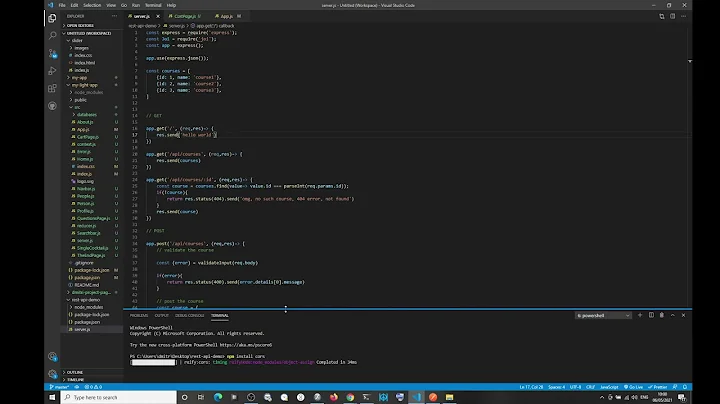how to bypass Access-Control-Allow-Origin?
Solution 1
Put this on top of retrieve.php:
header('Access-Control-Allow-Origin: *');
Note that this effectively disables CORS protection, and leaves your users exposed to attack. If you're not completely certain that you need to allow all origins, you should lock this down to a more specific origin:
header('Access-Control-Allow-Origin: https://www.example.com');
Please refer to following stack answer for better understanding of Access-Control-Allow-Origin
https://stackoverflow.com/a/10636765/413670
Solution 2
Okay, but you all know that the * is a wildcard and allows cross site scripting from every domain?
You would like to send multiple Access-Control-Allow-Origin headers for every site that's allowed to - but unfortunately its officially not supported to send multiple Access-Control-Allow-Origin headers, or to put in multiple origins.
You can solve this by checking the origin, and sending back that one in the header, if it is allowed:
$origin = $_SERVER['HTTP_ORIGIN'];
$allowed_domains = [
'http://mysite1.com',
'https://www.mysite2.com',
'http://www.mysite2.com',
];
if (in_array($origin, $allowed_domains)) {
header('Access-Control-Allow-Origin: ' . $origin);
}
Thats much safer. You might want to edit the matching and change it to a manual function with some regex, or something like that. At least this will only send back 1 header, and you will be sure its the one that the request came from. Please do note that all HTTP headers can be spoofed, but this header is for the client's protection. Don't protect your own data with those values. If you want to know more, read up a bit on CORS and CSRF.
Why is it safer?
Allowing access from other locations then your own trusted site allows for session highjacking. I'm going to go with a little example - image Facebook allows a wildcard origin - this means that you can make your own website somewhere, and make it fire AJAX calls (or open iframes) to facebook. This means you can grab the logged in info of the facebook of a visitor of your website. Even worse - you can script POST requests and post data on someone's facebook - just while they are browsing your website.
Be very cautious when using the ACAO headers!
Solution 3
Warning, Chrome (and other browsers) will complain that multiple ACAO headers are set if you follow some of the other answers.
The error will be something like XMLHttpRequest cannot load ____. The 'Access-Control-Allow-Origin' header contains multiple values '____, ____, ____', but only one is allowed. Origin '____' is therefore not allowed access.
Try this:
$http_origin = $_SERVER['HTTP_ORIGIN'];
$allowed_domains = array(
'http://domain1.com',
'http://domain2.com',
);
if (in_array($http_origin, $allowed_domains))
{
header("Access-Control-Allow-Origin: $http_origin");
}
Solution 4
I have fixed this problem when calling a MVC3 Controller. I added:
Response.AddHeader("Access-Control-Allow-Origin", "*");
before my
return Json(model, JsonRequestBehavior.AllowGet);
And also my $.ajax was complaining that it does not accept Content-type header in my ajax call, so I commented it out as I know its JSON being passed to the Action.
Hope that helps.
Solution 5
It's a really bad idea to use *, which leaves you wide open to cross site scripting. You basically want your own domain all of the time, scoped to your current SSL settings, and optionally additional domains. You also want them all to be sent as one header. The following will always authorize your own domain in the same SSL scope as the current page, and can optionally also include any number of additional domains. It will send them all as one header, and overwrite the previous one(s) if something else already sent them to avoid any chance of the browser grumbling about multiple access control headers being sent.
class CorsAccessControl
{
private $allowed = array();
/**
* Always adds your own domain with the current ssl settings.
*/
public function __construct()
{
// Add your own domain, with respect to the current SSL settings.
$this->allowed[] = 'http'
. ( ( array_key_exists( 'HTTPS', $_SERVER )
&& $_SERVER['HTTPS']
&& strtolower( $_SERVER['HTTPS'] ) !== 'off' )
? 's'
: null )
. '://' . $_SERVER['HTTP_HOST'];
}
/**
* Optionally add additional domains. Each is only added one time.
*/
public function add($domain)
{
if ( !in_array( $domain, $this->allowed )
{
$this->allowed[] = $domain;
}
/**
* Send 'em all as one header so no browsers grumble about it.
*/
public function send()
{
$domains = implode( ', ', $this->allowed );
header( 'Access-Control-Allow-Origin: ' . $domains, true ); // We want to send them all as one shot, so replace should be true here.
}
}
Usage:
$cors = new CorsAccessControl();
// If you are only authorizing your own domain:
$cors->send();
// If you are authorizing multiple domains:
foreach ($domains as $domain)
{
$cors->add($domain);
}
$cors->send();
You get the idea.
Related videos on Youtube
ETAN
Updated on January 08, 2021Comments
-
ETAN over 3 years
I'm doing a ajax call to my own server on a platform which they set prevent these ajax calls (but I need it to fetch the data from my server to display retrieved data from my server's database). My ajax script is working , it can send the data over to my server's php script to allow it to process. However it cannot get the processed data back as it is blocked by
"Access-Control-Allow-Origin"I have no access to that platform's source/core. so I can't remove the script that it disallowing me to do so. (P/S I used Google Chrome's Console and found out this error)
The Ajax code as shown below:
$.ajax({ type: "GET", url: "http://example.com/retrieve.php", data: "id=" + id + "&url=" + url, dataType: 'json', cache: false, success: function(data) { var friend = data[1]; var blog = data[2]; $('#user').html("<b>Friends: </b>"+friend+"<b><br> Blogs: </b>"+blog); } });or is there a
JSONequivalent code to the ajax script above ? I thinkJSONis allowed.I hope someone could help me out.
-
 Moradnejad over 7 yearsall the answers to your question so far explained a way to rewrite your server code so you ajax will work. None of them is about bypassing, as you asked specifically in your question. Did you find anyway to actually bypass this header? I really doubt that there would be one.
Moradnejad over 7 yearsall the answers to your question so far explained a way to rewrite your server code so you ajax will work. None of them is about bypassing, as you asked specifically in your question. Did you find anyway to actually bypass this header? I really doubt that there would be one. -
 Jonathan Pauw about 4 yearsthere is no way to baypass it. but you can put a file on your backend that performs the request. So you call per ajax the file on your own server, that file loads the data from retrieve.php and send them back to your javascript. In that case there are no CORS rules blocking you.
Jonathan Pauw about 4 yearsthere is no way to baypass it. but you can put a file on your backend that performs the request. So you call per ajax the file on your own server, that file loads the data from retrieve.php and send them back to your javascript. In that case there are no CORS rules blocking you. -
 NVRM over 3 yearsThe secure websocket protocol
NVRM over 3 yearsThe secure websocket protocolwss://is not subject to CORS blocking.
-
-
Daniel Brockman over 12 yearsIt is an HTTP header that your server sends to inform the browser that it is okay to reveal the result to the calling script despite the fact that the script’s origin domain does not match the server’s domain. Read up on Cross-Origin Resource Sharing!
-
 Rob almost 11 yearsThats rather unsafe. Check out my answer at the bottom.
Rob almost 11 yearsThats rather unsafe. Check out my answer at the bottom. -
Rafay over 10 yearstnx, but you should not allow access to all origins as mentioned by @RobQuist in his comment, and in his answer provided a better approach
-
 Shawn Whinnery about 10 yearsSo I found this page because I needed to actually 'bypass' Access Control on a server. The solution here isn't bypassing anything but simply properly configuring Access Control on his own server. In case anyone out there actually needs to bypass this they can use PHP's file_get_contents($remote_url);. There are obviously many ways to do this but this is how I did it.
Shawn Whinnery about 10 yearsSo I found this page because I needed to actually 'bypass' Access Control on a server. The solution here isn't bypassing anything but simply properly configuring Access Control on his own server. In case anyone out there actually needs to bypass this they can use PHP's file_get_contents($remote_url);. There are obviously many ways to do this but this is how I did it. -
 Rob about 8 years@ShawnWhinnery that is basically the act of "proxying". Good solution if you really want to dynamically load data from another website that you have no control of.
Rob about 8 years@ShawnWhinnery that is basically the act of "proxying". Good solution if you really want to dynamically load data from another website that you have no control of. -
Rafay over 6 yearswhat exactly didnt work @jairhumberto any errors on the browser console? or on the server end? how does your code look like?
-
jairhumberto over 6 yearsnope, nothing. just nothing happens as if the code wasnt even there. I just try to make an ajax request to another domain file that has as the first line the header setted via header function
-
 Rob over 6 yearsThis is an even better solution that the one I posted.
Rob over 6 yearsThis is an even better solution that the one I posted. -
 raddevus about 6 yearswanted to run PHP script from dotnet core - moved php script to my other URL but was getting cross-site scripting error. added the code you showed to top of PHP and worked perfectly. Thanks!
raddevus about 6 yearswanted to run PHP script from dotnet core - moved php script to my other URL but was getting cross-site scripting error. added the code you showed to top of PHP and worked perfectly. Thanks! -
mopsyd about 6 yearsThis is a poor practice, and leaves you wide open for cross site scripting. You pretty much only want your own domain allowed by default. The answer you really want is this:
header('Access-Control-Allow-Origin: ' . 'http' . ( ( array_key_exists( 'HTTPS', $_SERVER ) && $_SERVER['HTTPS'] && strtolower( $_SERVER['HTTPS'] ) !== 'off' ) ? 's' : null ) . '://' . $_SERVER['HTTP_HOST'] ); -
mopsyd about 6 yearsWhat this does, is allow your own domain, and honors the current SSL settings on your server. If you want to add access for additional domains, just add another
Access-Control-Allow-Originheader for each additional domain. -
 CodeChari over 2 yearsHTTP_ORIGIN is not reliable, see stackoverflow.com/questions/41231116/…
CodeChari over 2 yearsHTTP_ORIGIN is not reliable, see stackoverflow.com/questions/41231116/…

![Fix CORS Error [SOLVED] | React Tutorial](https://i.ytimg.com/vi/hxyp_LkKDdk/hq720.jpg?sqp=-oaymwEcCNAFEJQDSFXyq4qpAw4IARUAAIhCGAFwAcABBg==&rs=AOn4CLDs0NMhm3WR0Mqp4qKMm_85b3Ee_A)




